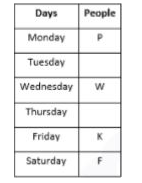Each of these questions consists of a question followed by information in two statements I and II. You have to study the question and the statements and decide that the information in which of the statements(s) is/are required to answer the question.
Six people have off on different days of the same week, starting from Monday and ends on Saturday. How many people have off between K and P?
I. Not more than two people have off after F. Two people have off between F and W. The number of people have off after F is same as the number of people have off before P.
II. Three people have off after W. One person has off between W and K.
Only statement I is sufficient
Only statement II is sufficient
Either statement I or statement II is sufficient
Both statements I and II are sufficient
The correct Answer is:D
From statement I:
Not more than two people have off after F. Two people have off between F and W.

The number of people have off after F is same as the number of people have off before P.
Here, Case 1 gets eliminated:

From statement II:
Three people have off after W. One person has off between W and K.

From both statements I and II:
Not more than two people have off after F. Two people have off between F and W. The number of people have off after F is same as the number of people have off before P. Three people have off after W. One person has off between W and K.

Hence, three people have off between K and P.
Clearly, both statements I and II are sufficient.
Similar Questions
KCl, NaCl प्रकार के समान जालक में क्रिस्टलीकृत होता है । दिया है rNa+/rCl−=0.55 तथा rK+/rCl−=0.74 तब KCl तथा NaCl के लिए इकाई सेल के किनारो का अनुपात ज्ञात कीजिए :
View Solutionनिम्नलिखित कथनों पर विचार करें :
कथन I : यदि A और B प्रतिदर्श समष्टि S के संगत दो घटनाएँ ऐसा है कि P(A)=0.2 और P((B)=0⋅8 तो A⋃B एक सुनिश्चित घटना है |
कथन I : यदि A और B परस्पर अपवर्ती हों तो P(A)+P(B)=1 इन कथनो में :
View Solutionनिम्नलिखित कथनों पर विचार करें :
कथन I : माना कि ddx{f(x)+c}=F(x) तब ∫F(x)dx=f(x)+c
कथन II : समाकलन, अवकलन का प्रतिलोम प्रक्रम है | इन कथनो में :
View Solutionनिम्नलिखित कथनों पर विचार करें :
कथन I : माना कि f:N→Y एक फलन है, जो f(x)=9x+3 द्वारा परिभाषित है, जहाँ Y={y:y=9x+3,x∈N} तो f एकैकी फलन है |
कथन II : x1,x2∈N के लिए f(x1)=f(x2)⇒x1=x2 इन कथनो में :
View Solutionनिम्नलिखित कथनों पर विचार करें :
कथन I : f(x)=4x3+9x2−12x के लिए स्थानीय अधिकतम का बिंदु है x=-2
कथन II : 'f(−2)=0 और f''(−2)>0. इन कथनो में :
View Solutionतीन छात्रों द्वारा किसी प्रश्न के हल करने की प्रायिकताएँ क्रमश: 13,14,15 है, तो प्रश्न हल किए जाने की प्रायिकता निकालें |
View Solutionपरासरण दाब (π), आयतन V व ताप T के लिए निम्न में से कौन-सा कथन सत्य है-
View Solutionरामू एक सब्जी उत्पादर हैं । वह अपने उपजाऊ भूमि में टमाटर लगाकर उच्च पैदावर प्राप्त करता हैं । लेकिन उसके खेत से मण्डी की दूरी अधिक थी तथा परिवहन के साधन भी उपलब्ध नहीं थे , जिसके परिमाणस्वरुप विलंब के कारण टमाटर सड़ जाते थे तथा बाजार में मूल्य नही मिलते थे ।
जब उसने कृषि विश्वविद्यालय में पढ़ने वाले अपने मित्र को समस्या से अवगत कराया तब मित्र ने उसे पारजीनी टमाटर की किस्म उगाने को कहा जो कि विलम्ब से पकता हैं ।
उपर्युक्त गद्यांश को ध्यानपूर्वक पढ़ने के बाद निम्न - लिखित प्रश्नों के उत्तर दीजिये - (i) पारजीनी (Transgenic) क्या हैं ?
(ii) पारजीनी टमाटर का उत्पादन कैसे किया जाता हैं ?
(iii) रामू के मित्र व्दारा किन मूल्यों का प्रदर्शन किया गया ?
View Solution
